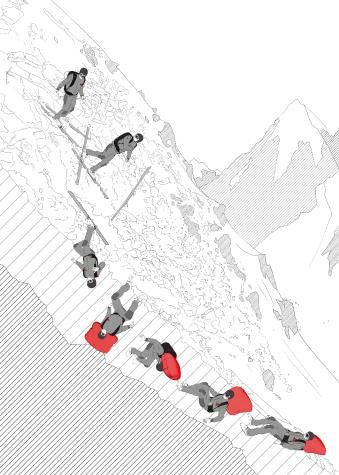If you are traveling in avalanche terrain you have got to carry the right gear and know how to use it. Avalanche airbags, or balloon packs, are growing in popularity and now considered by many to be the fourth item complimenting the essential life-saving trio of an avalanche transceiver, probe, and shovel. While never a substitute for proper training and good decision making, airbags can offer an added level of protection in the event of avalanche involvement.
Airbags are proven to save lives, in fact, about half of avalanche victims who would have otherwise died[1]. The majority of avalanche related fatalities occur due to asphyxiation with survival rates plunging dramatically after 15 minutes for buried victims[2]. By keeping victims on, or close to the surface, airbags can reduce this critical burial time while also offering protection from trauma which may occur as riders are swept along in the debris flow.
Airbag science in a ‘Nut Shell’
 Airbag systems are comprised of a handle pulled to activate 3-second gas or electric fan inflation of a 150L tearproof balloon incorporated into a backpack or vest which deploys around the wearers head, neck and chest. The T-handle can be stowed away when not being worn to prevent accidental inflation, such as when being transported in a vehicle. Packs and vests include reinforced hip belts and a leg strap which prohibits the airbag from being pulled off or over your head in the event of an avalanche.
Airbag systems are comprised of a handle pulled to activate 3-second gas or electric fan inflation of a 150L tearproof balloon incorporated into a backpack or vest which deploys around the wearers head, neck and chest. The T-handle can be stowed away when not being worn to prevent accidental inflation, such as when being transported in a vehicle. Packs and vests include reinforced hip belts and a leg strap which prohibits the airbag from being pulled off or over your head in the event of an avalanche.
 The science driving the design of airbag technology relies on a process called inverse segregation, or the ‘Brazil Nut Effect’. This theory states that in an equally moving mass of particles, the smaller particles gravitate to the bottom while the larger ones rise to the surface. The flowing motion of an avalanche and its snow particles has a similar effect as shaking a can of mixed nuts; with the larger nuts, or deployed airbag, rising to the top. The volume and bright color of the balloon can also assist with visual location of a victim on the surface.
The science driving the design of airbag technology relies on a process called inverse segregation, or the ‘Brazil Nut Effect’. This theory states that in an equally moving mass of particles, the smaller particles gravitate to the bottom while the larger ones rise to the surface. The flowing motion of an avalanche and its snow particles has a similar effect as shaking a can of mixed nuts; with the larger nuts, or deployed airbag, rising to the top. The volume and bright color of the balloon can also assist with visual location of a victim on the surface.
Want to get nitty-gritty on Inverse Segregation and The Brazil Nut Effect? Check out this YouTube video which gets deep into it. (But then rises to the surface - get it?!)

Advancements in technology have created lightweight and affordable options with a diverse range of features to suit a wearer’s specific needs. Airbags are a functional safety device right off the shelf; they require little training or maintenance other than a daily check to ensure the gas cylinder is fully pressurized or the electric system is charged and switched on before use. If the airbag is deployed, it can be prepared for re-use by deflating and repacking the balloon, replacing the burst disk or o-ring, and re-charging the battery or refilling the compressed gas cylinder at an authorized dealer or SCUBA/ paintball shop. Airbags should be tested once a season to ensure function and familiarity with deployment for effectiveness.
~Nicole Matei, Guide & Avalanche Educator for Elk Valley Snow Shepherds. Nicole is also a Paramedic, Canadian Avalanche Association ITP Level 2 student, a 20-year vet of ski patrolling and mountain safety dispatching, holds Ground Search and Rescue / Air Search and Rescue certificate, is the Executive Admin for the Fernie Snowmobile Association, and is a self-proclaimed (though we'll back her on this) powder princess.
[1] Pascal Haegeli. An Up-to-Date Perspective on the Effectiveness of Avalanche Airbags. (The Avalanche Review, VOL. 33, NO. 1, SEPTEMBER, 2014).
[2] Haegeli, Pascal & Falk, Markus & Brugger, Hermann & Etter, Hans-Jürg & Boyd, Jeff. (2011). Comparison of avalanche survival patterns in Canada and Switzerland. CMAJ : Canadian Medical Association journal = journal de l'Association medicale canadienne. 183. 789-95. 10.1503/cmaj.101435.

